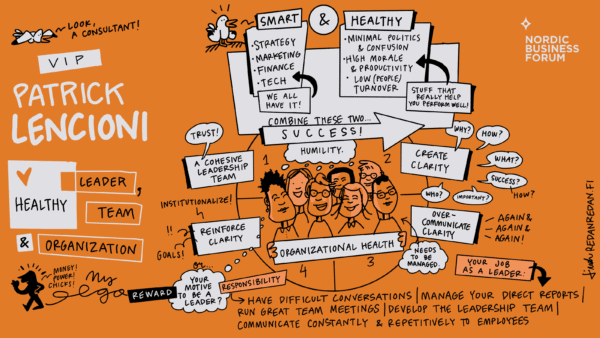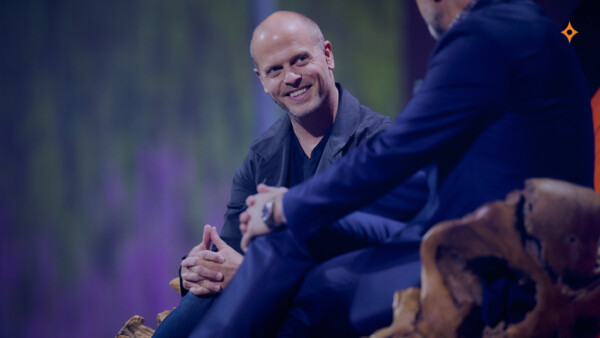18Oct2023
Patrick Lencioni began his VIP session at NBF 2023 with an unusual request: “I love to be interrupted. I’m really more of a talker than a speaker, and I’m a consultant at heart. So if there’s something that you wanna ask, raise your hand. And we’ll take that question during my talk. That will be a big favor for me.” Though it took just about 9 minutes, the audience did take him up on his request. And it made for an engaged and lively session.
Patrick’s focus in the session was on building and sustaining healthy companies. In order to be successful, a company must meet 2 requirements: it must be both smart and healthy.
And while the focus tends to be on the “smart” things, such as strategy, marketing, finance, and technology, because that’s where things are fun and measurable, Patrick admitted he doesn’t see much value in spending more time there. As he put it: “I have yet to go into a company and spend a couple days with the leadership team and walk away and say, ‘they’re too dumb to be successful.’ It’s never that. I mean, we have access to information like never before, but how many of [the companies] are unhealthy? So many are.”
The 4 Disciplines of Organizational Health
So how does an organization become healthy? Patrick was just about to tell the audience at the VIP session that it boils down to 4 basic practices, when—as he requested—an audience member named Amy interrupted him. Amy’s an American who’s been working in Switzerland for a while—studying the ego, power, and authority. She wanted to know how we can build healthy organizations in the face of mounting egos and grabs for power.
Pat’s mastery of tying things together showed through as he turned that interruption into a segue to his main point. He said, “At the heart of every healthy organization is humility.” He recounted a definition of the term attributed to English author C.S. Lewis: “Humility is not thinking less of yourself that you should. It’s thinking about yourself less.” Humility in an organization would look like people who are good at things recognizing and leveraging what they’re good at—while also using it to help others in the company.
Patrick was quick to point out that despite all the praise being heaped upon Silicon Valley, it’s a terrible place to look for good leaders because it seems difficult to find humility there. And because of that, we tend to find much less cohesion—which led him into talking about the 4 disciplines of a healthy organization.
Those 4 disciplines can be further distilled down to 2 traits: cohesion and clarity. Cohesion must be built within the leadership. Then it’s used to create clarity—which needs to be communicated and reinforced throughout the life of the company.
Cohesion (Build it)
The leaders of an organization need to be cohesive if there’s any hope for the organization to survive and thrive. But what does cohesion mean? Patrick sums it up elegantly with some key behaviors.
“We have to build a cohesive leadership team that trusts each other and argues well, has good conflict, commits to decisions and holds each other accountable and gets results.”
Patrick recounted how he had just met with the Defense Minister of Norway—who runs an organization of thousands—and said to him that running his organization isn’t that different from running a small company. “If the people at the top aren’t very cohesive, it’s gonna cascade throughout the entire organization.”
Clarity (Create it)
So how do you create clarity among your leaders? It is as simple as getting your leaders to have the same answers to 6 critical questions.
Why Do We Exist? – In other words, why is this an organization? Why does this matter?
How Do We Behave? – What are our core values? But more importantly, what are the 2 or 3 behaviors such that if you don’t have those—you don’t belong?
What Do We Do? – What do we actually do? What do we provide and how do we bring value?
How Will We Succeed? – What is our strategy? How will we be unique and intentional?
What is Most Important Right Now? – What is the current rallying cry? What priority pulls at the leaders and impassions them?
Who Must Do What?
As simple as these questions are, Patrick lamented that often, when he begins to work with leaders at a company—it’s astonishing how many of them don’t (or can’t) agree on the answers.
Clarity (overcommunicate it)
Once the work of getting leaders on the same page with those 6 questions is done, the hard work really begins. Leaders need to not just communicate the answers to those questions, they need to overcommunicate them. As Patrick points out,“…research shows that employees in your organization have to hear things seven times before they believe it.”
In fact, communicating this message is so important that Patrick jokes about CEOs, “I like to say you’re actually the CRO, the Chief Reminding Officer. This is one of the most fundamental things leaders need to do, is to over-communicate. And if you’re a parent, you know this with your children. You have to say it again and again and again. And just when they’re so tired of hearing it and you’re so tired of saying it, that’s when they begin to remember it.”
Clarity (reinforce it—but don’t bureaucratize it)
Communication needs to be consistent, repetitive, and ongoing when it comes to the 6 critical questions. But to maintain cohesion throughout the life of an organization and its growth, you need systems that reinforce the message. Patrick listed things like:
- Hiring profiles
- Performance management conversations
- Goal-setting
But he warned that you need to find a sweet spot that’s just enough for people to follow the systems, but not so systematized that people get overwhelmed by it.
The Right Reasons to Lead
As Patrick closed the book on organizational health, he turned to some warnings about leadership—and the different motivations for becoming a leader. He said there are basically two kinds of leaders:
- Reward Centered Leaders are motivated by the money, recognition, or power that often comes with being a leader.
- Responsibility Centered Leaders recognize the burdens that come with leadership. They may choose to lead, but feel the gravity of being responsible for the fates of so many people—and take that seriously.
It’s common for people to slide between these two kinds of mindset—moving from one during part of their career to another, and sometimes back again. So leaders, and those coaching them, need to be aware of these differing motivations—because they can be what makes the difference between a healthy and unhealthy organizational culture.
Psst! Want to get the full summary of the Nordic Business Forum 2023 speeches + extra content for reflecting on your learning? Download your free copy of the full Executive Summary and summaries from previous events!
The 5 Omissions of Reward Centered Leaders
The problem with reward centered leaders is that they fail to do five key things that are critical for providing good leadership.
Having Difficult and Uncomfortable Conversations
Patrick recounted 2 stories that exemplify this behavior. One involved a CFO who told Patrick that he didn’t believe in what his company had hired Patrick to do—even though the company’s CEO was fully bought in. But when confronted, the CEO continued to avoid—even at Patrick’s insistence—having a conversation with this dissenting CFO.
The other story involved a CEO who was so repulsed by having difficult conversations that rather than firing or demoting his CTO, he simply hired another CTO—while refusing to talk the current one. He wouldn’t even take a meeting with him. And eventually, the CTO left the company.
That kind of behavior, Patrick reminded the audience, flows downward. If you avoid difficult conversations with your team—they’ll do the same with their teams. It becomes a sickness that spreads throughout the company.
Managing Your Direct Reports
Many CEOs tend to find themselves tired of managing people by the time they get into that position. And as they become reward centered, they’re so attracted to giving speeches, going on TV, and being public figures, that they forget what was perhaps the most memorable line of Patrick’s VIP session: “everybody needs to be managed.”
Being a good leader means remembering the responsibility you have to your direct reports: to manage them—because we all need the help of someone managing us.
Running Great Team Meetings
It’s a fairly worn-out trope by this point to complain about meetings. Even many leaders complain (and find others agreeing with them) that meetings are a problem. But Patrick voiced his passionate disagreement with that opinion.
“When a leader says ‘I don’t like meetings,’ what they’re really saying is ‘I don’t like my job,” he emphatically told the audience. “It’s not the meetings that are the problem. It’s bad meetings that are the problem.”
To further drive home the point, Patrick issued this directive to the leaders in attendance: “Your meetings should be gritty and passionate and intense and tiring and uncomfortable—because you’re talking about things that matter. And the only person who can make a meeting great is the leader.”
Developing the Leadership Team
While things like retreats and team-building exercises can be organized and aided by HR or consultants (like Patrick), a leader has the responsibility of developing their leadership team. There’s no getting around it. And while many CEOs may not want to do it, that is their job.
Good leaders feel the responsibility—to their teams and their company—to make sure the leaders are the best they can be. So they invest time and energy in doing it. But those who lead because they enjoy the rewards will overlook how important it is to invest in the often difficult work of developing their teams.
Communicating Constantly and Repetitively to Employees (Be a CRO [Chief Repetition Officer])
Perhaps the easiest thing for leaders to let fall through the cracks is repeating the messages that are part of the answers to those 6 critical questions. It’s easy to avoid doing it for reward centered leaders because it’s not fun and can seem like overkill. But as Patrick reassured the audience, it’s absolutely necessary.
To hammer home the point, he used the analogy of a husband whose wife laments that he never tells her he loves her anymore—to which the husband replies “well, I told you once. I’ll let you know if anything changes.”
That’s unfortunately the attitude many leaders have when they claim they sent out the memo or the slide deck, so there’s no need to keep communicating what was in it. When it comes to important messages like reassurances of love or the critical points of your company culture—things need to be repeated often. Otherwise, atrophy can very easily set in.
Okay, but How Do We Measure it?
As Patrick ended his talk, and some more questions came from the audience, a few thematic questions developed: how do you measure these things having to do with culture? How do you know when a company is ready to really work on their culture? How do you reassure detractors that this stuff is really worth working on? And how do measure the ROI of that work?
Patrick quickly mentioned the case of Southwest Airlines—a small domestic airline in the US that became the most profitable airline in the US for decades, and retained much of its core team for a long time. But what isn’t as widely discussed is just how much they focused on culture. And when leaders there were asked how much their work on culture impacted the success of the business, their response was “it’s everything.”
And while in hindsight after success, it may be easy to praise working on culture, there are detractors to that approach. They are those who either view working on culture as not “macho” enough, or simply fluff with no KPIs to show its impact. To those detractors, Patrick closed his discussion by reminding the audience that—if pressed—we can offer a simple set of 3 KPIs related to measuring the impact of organizational health. “If you’re running a good organization and it’s a healthy company, good people stay. Your customers like what you do. And it works.”

Visual summary of the VIP Session by Linda Saukko-Rauta


